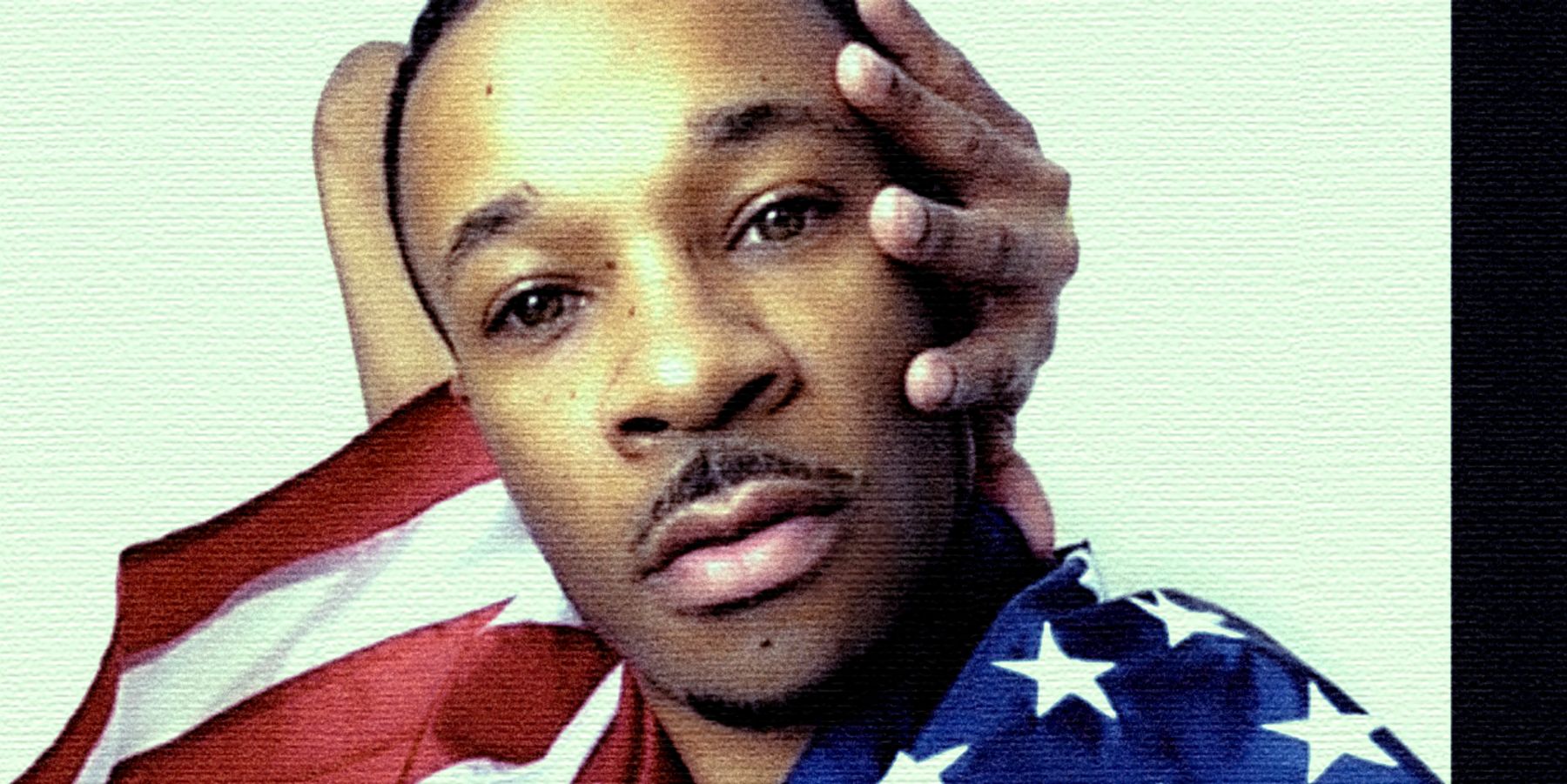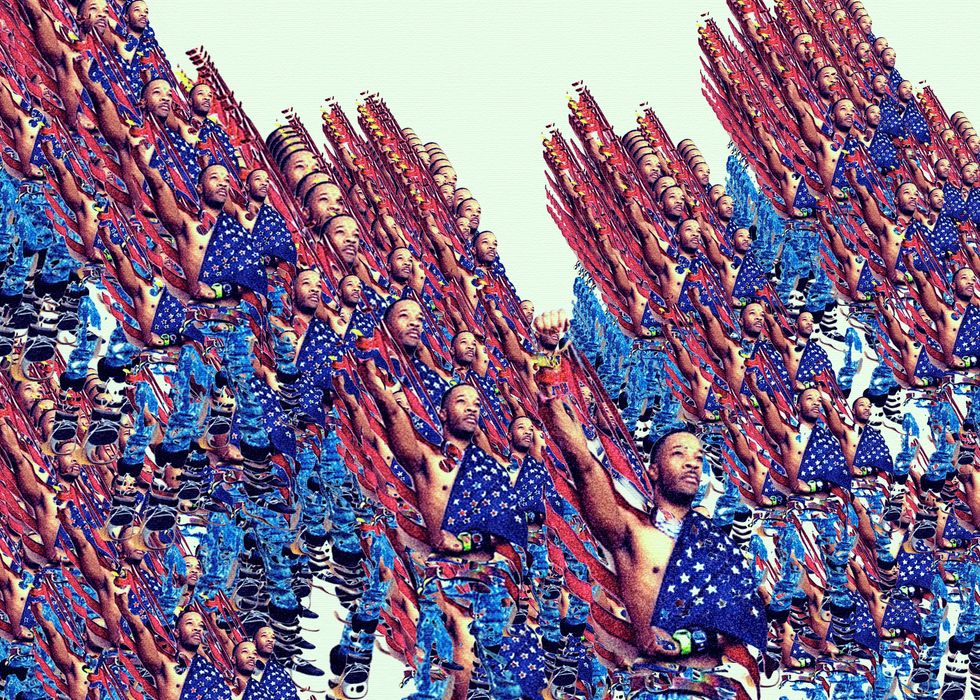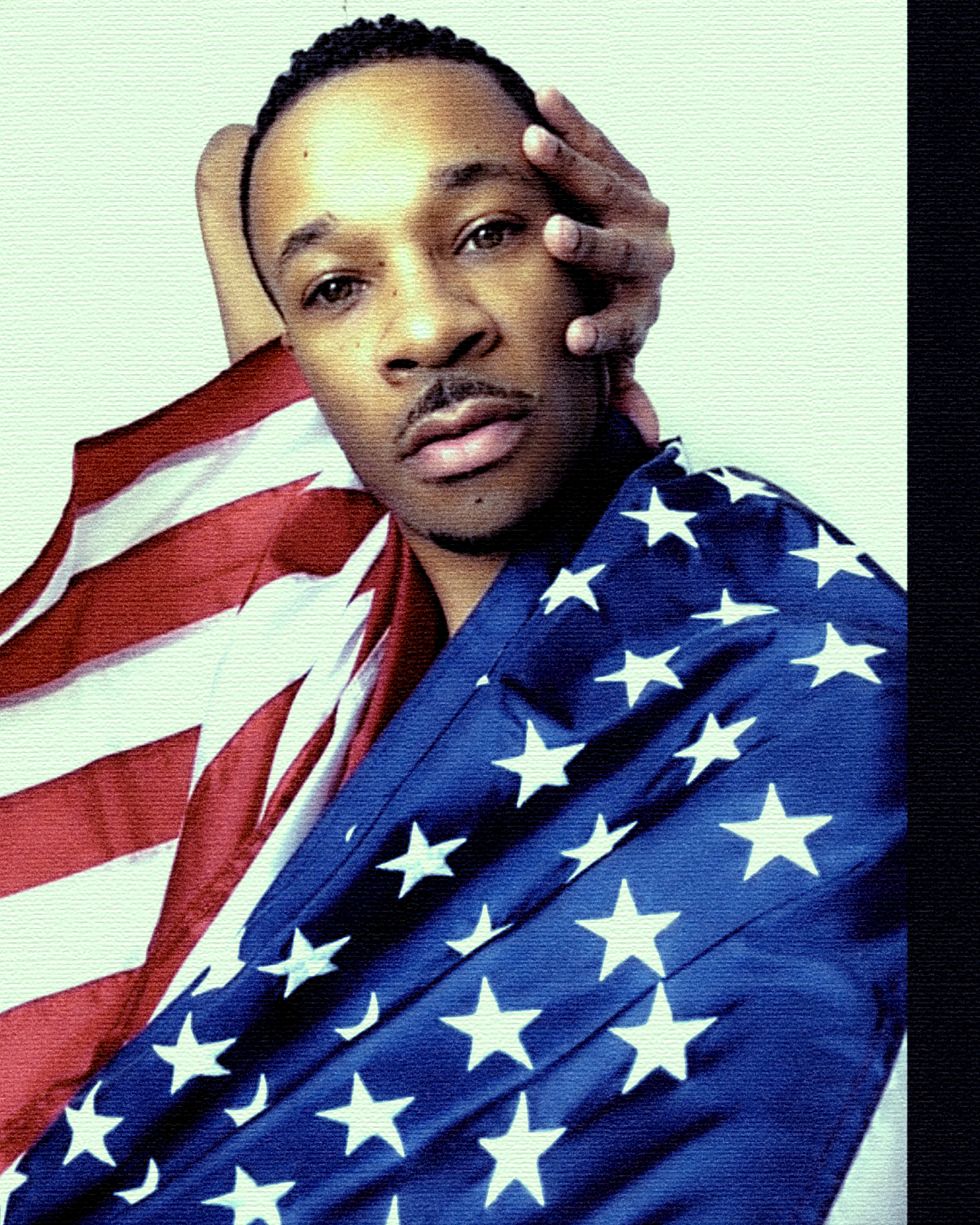
Pride
How Richy Jackson Got America Dancing
Story by Evan Ross Katz / Photography by Oscar Ouk (Using Zoom)
18 June 2020

Choreographing an entire set for what will likely be one of the biggest, if not the biggest, tours of 2020? And doing it without your star, your dancers or a dance studio? No big deal if you're Richy Jackson, who is hard at work prepping the launch of Lady Gaga's Chromatica Ball, 13 years after the pair first met and began working together. You know the moves. From "Just Dance" to "Bad Romance" to "Born This Way" to "Applause" to "Rain On Me," Jackson has worked with the Italian girl from New York in crafting the "walk walk" that moves the "fashion baby."
Related | Lady Gaga: Life on Chromatica
But his work as a central figure in the music industry stretches back way earlier, to an appearance in NSYNC's "Pop" video followed up immediately with Blu Cantrell's "Hit 'Em Up Style (Oops!)" and Usher's "U-Turn." Is that him in Missy Elliott's "Gossip Folks"? Of course it is. He honed the skills he developed as a dancer and parlayed that into a career as a choreographer working with Keri Hilson, JoJo and, of course, Stefani Joanne Angelina Germanotta.
Below, Jackson reflects on his journey and the bygone era of pop stars he witnessed in his youth, details choreographing some of Gaga's most iconic moves and discusses why there's more to JoJo Siwa than meets the eye.

Let's take a time machine back a bit. What was your early life like before you began your professional journey?
I've been dancing since I was three years old. My mother used to have a cheerleading squad called the Fairfield Falcons. They were a part of what would be described as a junior cheerleading league. And so I started choreographing for the squad when I was 13. And from that choreography they won regionals, they won state, and then they were supposed to go to nationals but they couldn't afford it. So that was my first taste of choreographing. I was also heavily involved in band. Since the fourth grade I was a percussionist. And in junior high and into high school I became percussion captain. I also played in jazz band and in marching band.
Who were the artists that you had your eye on from an early age?
The people I liked to watch when I was younger were Michael Jackson, Janet Jackson, MC Hammer and movies like Breakin' and Breakin' 2. I just loved everything that was surrounded by dance. But also I loved music. I was just so into band and I feel like those two things are what heavily influenced me as a choreographer. Me and my friends when we were 16, we would sneak into clubs and go dancing. Sometimes we'd get caught but if we didn't get caught, we were there the whole night dancing down to the music.
These days, thanks to YouTube and shows like America's Best Dance Crew and So You Think You Can Dance, there is so much access to an array of choreography. When you were younger, who were the choreographers you were looking to and how did you find their work?
First of all Tina Landon, who choreographed most of Janet Jackson's hits. You know those videos, I used to love them. I love Paula Abdul. I never knew who choreographed Michael Jackson's videos until later on in my career, but I loved Michael Peters. "Thriller" is one of my favorite videos on the planet. I love "Bad" and I love "Smooth Criminal." Studying their work was just watching videos on TRL and hoping that they would come on the screen and that you'd be there to press record on your VHS, then you'd play it back and just keep watching it. It was hard to learn things back then because it took a while to rewind a VHS tape.
I remember those days vividly because it really was our only access to watching music videos.
I think that artists back then fought to be so different and so good. You had to be good. That's the thing about back then, yeah, it was definitely harder to get in, but it was worth it if you got in. I think today anyone can get in. And there's just an overflux of music and content. What we saw back then was actual quality. You had to be great from the recording of the music to the making of the music video to the live performances. Everything had to be at a 10.
So then you began working as a dancer. Your resume just from your dancing alone needs to be discussed and dissected. NSYNC's "Pop," Blu Cantrell's "Hit 'Em Up Style (Oops!)," Missy Elliot's "Gossip Folks," the list goes on and on. Do you have a favorite among them?
I'd have to say "Gossip Folks" with Missy. That was my first time linking up with Missy and working with her choreographer Hi-Hat at the time. Of course I loved dancing in that Blu Cantrell video. That was also the first time I ever assisted anybody. So I actually choreographed and danced in that video. This isn't necessarily videos, but I loved doing all of those iPod spots. When the iPod first came out I did two commercials for Apple that was amazing because it was so new. No one even knew what an iPod was. I also loved dancing with Will Smith at the 2001 Grammys. That was one of my first big jobs. Those days were just so exciting because I had the chance to work with so many different choreographers and that's what helped me ultimately not necessarily develop my style but understand movements and be able to learn different ones from so many different choreographers.

I'm fascinated by this idea of finessing one's own style, taking from various places of inspiration — whether it be a mentor or just something you saw someone do — and translating it into something that is yours. How did you go about cementing your own imprint on this work?
It's all about branding. I like that Missy looks like Missy. I like that Janet looks like Janet. I like that Will Smith looks like Will Smith. Back then there were a bunch of different choreographers, even between most of the artists I named. But I also did not like sometimes knowing who the choreographer was. Meaning, if I saw the same moves on a few different artists I would know who the choreographer was. And I didn't like that because I thought it was so important that each artist had their own vibe. So what I told myself was that if I was to get three different kinds of artists I would want to figure out what their style is as far as what does a Gaga need to look like, what does a JoJo Siwa need to look like, what does a Mario need to look like. And not make it about me. Make it about how to keep their branding to themselves, like stay on brand with the movement in terms of how they look and how the music sounds. I want to be able to work with as many clients as possible but within that, I need to be able to keep their brand alive even down to the dance style.
Getting into the Gaga of it all, one of the things I find so interesting about your work with her is the longevity. You've been able to witness the finesse of her artistry from an early stage. When you first met her early on — and I think it's fair to say she was less of a dancer than she is now, no shade — what stands out for you about those early rehearsal sessions together?
Prior to her I had just always had this idea and this dream to work with someone who wanted it just as bad as I did, someone who wasn't afraid to go outside the box. I think that upon meeting her — I met her in 2007 — that idea of people wanting to go outside the box, people really wanting to go for it, I just didn't see that in some of the artists I was beginning to take on. But when we met she performed three songs for me and her conviction in those songs, her believability — and I knew she was a theater girl — it just came through. And from that point I said, "Yes, this is the kind of artist I've been waiting for, someone who can sell it and whether it's right or wrong I still believe their story." And that's what I got out of her when I first met her that I didn't see in anybody else. There was a fearlessness and a desire to be great and I resonated with that because I felt the same way in my craft.
Is there a particular video that you did with her where you can detail how you came up with a certain move?
So like the chorus on "Bad Romance"...
You're speaking my language.
That chorus, "I want your lovin'/I want your revenge/You and me could write a bad romance…" those first moves where the arms open out and then come to her chest and then open out and then down… that was me saying here she is giving herself to her man and opening herself up to this person. So that's why it goes out and then closes and then comes up and then comes down. But then by the time you get to the snappy part, the "Ra-ra-ah-ah-ah Roma-roma-ma," that part to me was so shady. I was like the club kid that got to live at this part. I literally thought about the way she sang it but also how it would look on her and the girls but also the club kids because I'm still a club guy first. So I thought what are they gonna wanna do? They're gonna want to dance whether they're drunk, high, you name it. Everyone can do this snap and feel like they're the shit.
More please, more!
When you get something like "Telephone" and we're in that diner, in that moment I said, "We're just in a diner full of people, but what's the depth there like?" And also if we're going to have Beyonce with us, "What is that first move going to feel like?" So that sort-of side move that we start with during the "Stop callin', stop callin'/I don't wanna think anymore" it just felt like we were making a real statement almost like leave us alone and we're gonna dance you out of here if we have to. And that's what I felt like in those first four counts when we were doing that side-to-side movement. It's got to feel hard. And maybe we don't face the front; let's start at the side to give everyone a different visual. And because the music dictates so much, I listen and listen to the song to determine what did we just come from doing prior and where do we need to go next? I'm always thinking about where we left off and where we need to go.
In the "Applause" video when you have that series of hand gestures in the abrupt final seconds... can you talk about that extremely iconic sequence that has stuck with me even all of these years later?
I think we were in rehearsal for three of four days and I was like "Okay, what needs to seal the deal?" Of course she said it, "A-R-T-P-O-P," but I was like, "If we did some kind of hand gesturing, sign language to this part then me as a pop lover would die." And I was thinking what can we do with both of our hands. And I made it up on the spot during that last hour of rehearsal and I said this is how we gotta end this routine. It needed a visual period.
Looking at "Stupid Love," the first single off of Chromatica that dropped in February, you have this fanbase clamoring for the song and the video. How does it impact your process when you have an artist like Gaga who you know that immediately after something is released is going to be feeding a whole ecosystem of dancers and Tik-Tokers recreating the moves?
Again it's where did we come from prior to this? The last thing we did pretty much was Joanne, the album. I'm also thinking about what the club kids are gonna like, what her fan base is going to like and what we need to do to get new fans. And also, we are in, as you said, the Tik-Tok era, so I have to think about what can be repeated. What's going to resonate to that crowd as well? I had to find a way to appease and give every section of pop culture today something to recognize and bring all of them together as one.
Who in your life is someone that when they give you a compliment, when they see your work and tell you "Richy, you really killed it on this," it means the absolute most?
One of my best friends is another choreographer, his name is Rosero McCoy, he did Usher's "You Make Me Wanna" and Toni Braxton's "He Wasn't Man Enough For Me." He is someone that he will call me when these videos come out and just be like, "Wow, I'm so proud of you, you really keep pushing the bar, you're still show us new things, new vibes." His compliments and his commentary on it is always important to me because he's someone who's been out here choreographing before I knew that I could even do it. And he just keeps it very real with me and tells me if he likes it or not.
You mentioned earlier this idea of people back in the day needing to have real talent in order to make it. Who are some folks on the up-and-up that you really look at and get that same sensibility from in terms of really having the full package?
Who I love right now is JoJo Siwa. I met her at nine and she's now 16 and I knew she always wanted to be a performer and an entertainer and just seeing her grow from an idea to seeing what she's done now has been incredible. I've been working with her for about a year and a half now, I choreographed her D.R.E.A.M. tour and six of her music videos and what I love about her is that she has a message for young kids and she sticks to that message and everything about her is on brand, from the hair bows to the outfits to the performances. I love that she's giving kids their own superstar. She's always full-out, she works hard, and I feel like she has fought her way in this game. I absolutely love what she's been doing.
Obviously folks have their eyes set on The Chromatica Ball, which is at this time postponed. But that doesn't stop the creative process from happening. Is there anything you can tease about what we might expect from the tour?
We're gonna dance. [Laughs]. I mean, I've been listening to this album on repeat and getting all my ideas together. It's gonna be a fun fun fun moment. That's all I can say. We're gonna dance down!
Richy Jackson was photographed by New York-based photographer Oscar Ouk using Zoom